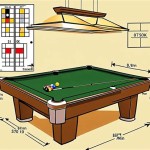The Enduring Appeal of the Round Table with Lazy Susan
The round table, a symbol of equality and shared experience, has seen numerous iterations throughout history. One particular evolution, the round table equipped with a Lazy Susan, has become a staple in dining rooms worldwide, particularly in cultures where communal meals are a cherished tradition. This design element, seemingly simple, introduces a dynamic of accessibility and convenience that fundamentally alters the dining experience.
The incorporation of a Lazy Susan, a rotating tray placed at the center of the table, addresses a common challenge in communal dining: reaching for dishes. In traditional settings, individuals might need to stretch, lean, or request others to pass food, disrupting the flow of conversation and potentially causing inconvenience. The Lazy Susan eliminates these issues, allowing each diner to access every dish with minimal effort. This contributes to a more relaxed and inclusive atmosphere, fostering a greater sense of connection and enjoyment during the meal.
The design also promotes a sense of order and control over one's own dining experience. Individuals can select the timing and quantity of food they wish to consume, without relying on the service of others. This can be particularly appealing in situations where diners have specific dietary needs or preferences. The Lazy Susan empowers each person to customize their plate and pace themselves comfortably, further enhancing the overall dining experience.
Enhanced Accessibility and Convenience
The primary benefit of a round table with a Lazy Susan lies in its ability to enhance accessibility. Without the rotating tray, diners seated further away from a particular dish face the aforementioned challenges of reaching and requesting. With the Lazy Susan, these challenges are negated. A simple rotation brings the desired dish within easy reach, regardless of seating position. This is particularly beneficial in larger groups, where the distance between diners and dishes can be considerable.
This enhanced accessibility translates directly into increased convenience. Diners can focus on the meal and the conversation, rather than expending energy and attention on maneuvering around the table. The Lazy Susan effectively democratizes access to the food, ensuring that everyone at the table has an equal opportunity to enjoy the full range of offerings. This contributes to a more equitable and enjoyable dining experience for all participants.
Furthermore, the Lazy Susan simplifies the act of serving and sharing. Hosts can easily place multiple dishes on the rotating tray, knowing that each item will be readily available to all guests. This reduces the need for constant intervention and allows the host to participate more fully in the meal and conversation. The design, therefore, benefits both the diners and the host, creating a more harmonious and relaxed dining environment.
Promotion of Communal Harmony and Interaction
Beyond its functional advantages, the round table with a Lazy Susan promotes communal harmony and interaction. The act of rotating the tray inherently involves a degree of consideration for others. Diners are encouraged to be mindful of the needs of those around them, ensuring that everyone has an opportunity to access the dishes they desire. This fosters a sense of shared responsibility and encourages collaborative behavior.
The rotating motion of the Lazy Susan also serves as a subtle reminder of the shared nature of the meal. It highlights the fact that everyone at the table is participating in a collective experience, bound together by the act of sharing food and conversation. This can be particularly valuable in fostering a sense of connection and belonging, especially in groups where individuals may not know each other well.
In many cultures, the act of sharing food is deeply ingrained in social customs and traditions. The round table with a Lazy Susan provides a physical manifestation of this concept, emphasizing the importance of communal dining and shared experience. It creates an environment where individuals are encouraged to connect with one another, engage in meaningful conversation, and build stronger relationships.
Space Optimization and Practical Considerations
While the social and experiential aspects are significant, the round table with a Lazy Susan also offers practical advantages in terms of space optimization. The rotating tray effectively increases the usable surface area of the table, allowing for a greater number of dishes to be accommodated. This is particularly beneficial in smaller dining spaces, where maximizing table space is a priority.
The Lazy Susan also helps to prevent clutter and disorganization. By providing a designated space for serving dishes, it discourages individuals from placing bowls and platters directly on the table surface. This contributes to a cleaner and more visually appealing dining environment. The rotating tray also makes it easier to clear the table after the meal, as dishes can be quickly and efficiently removed.
From a practical standpoint, the material and construction of both the round table and the Lazy Susan are important considerations. Tables are typically constructed from wood, metal, or glass, each offering different aesthetic qualities and levels of durability. Similarly, Lazy Susans are available in a variety of materials, including wood, glass, plastic, and metal. The choice of material should be based on factors such as personal preference, budget, and the overall style of the dining room. The size of the Lazy Susan should also be carefully considered, ensuring that it is appropriately proportioned to the size of the table and the number of diners.
The maintenance of a round table with a Lazy Susan is generally straightforward. Regular cleaning with a damp cloth is usually sufficient to remove spills and food residue. More stubborn stains may require the use of a mild detergent. It is important to avoid using abrasive cleaners, as these can damage the surface of the table or the Lazy Susan. The rotating mechanism of the Lazy Susan may require occasional lubrication to ensure smooth operation. A small amount of silicone-based lubricant can be applied to the bearing to prevent sticking or squeaking.
The style and design of the round table with a Lazy Susan can vary widely, ranging from traditional to contemporary. Traditional designs often feature ornate carvings and rich wood finishes, while contemporary designs tend to be more minimalist and streamlined. The choice of style should be based on personal preference and the overall aesthetic of the dining room. The round table with a Lazy Susan can be a versatile piece of furniture that complements a variety of décor styles. Its functionality and aesthetic appeal have contributed to its enduring popularity as a dining room centerpiece.

Forseti Round Dining Table With Lazy Susan Décor Manila

Lazy Susan Dining Table Ina Farm

59 1 White Black Round Dining Table With Lazy Susan Sintered Stone Top Homary

Pin On Housies

Botticino 1 35m Round Dining Table With Lazy Susan Sintered Furniture Home Décor Fortytwo

Magic Home 59 05 In Lazy Susan Rotary Round Black Sintered Stone Dining Table With Metal Legs Seat 8 Cs W308s00022 The Depot

Solid Oak Lazy Susan Table
/fit-in/562x562/media/catalog/product/_/4/_4_217.jpg?strip=all)
Luxury Round Marble Dining Table With White Lazy Susan

Modern 8 Seater Round Dining Table Led Lazy Susan Gloss White 160cm Quatropi

Magic Home 59 05 In Modern Round Rotary Lazy Susan Table Sintered Stone Tabletop Dining With 4 Black Metal Legs Seats 6 Mh A R150wb L1b The Depot








